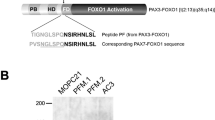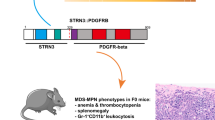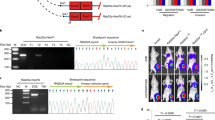Abstract
We have examined the structure and expression of the products associated with the t(2;13)(q35;q14) translocation associated with alveolar rhabdomyosarcoma. The chromosome 13 gene (FKHR) is identified as a member of the fork head domain family of transcription factors characterized by a conserved DNA binding motif. Polymerase chain reaction analysis demonstrates that a 5′ PAX3–3′ FKHR chimaeric transcript is expressed in all eight alveolar rhabdomyosarcomas investigated. Immunoprecipitation experiments detect the predicted fusion protein. These findings indicate that the t(2;13) generates a potentially tumorigenic fusion transcription factor consisting of intact PAX3 DNA binding domains, a truncated fork head DNA binding domain and C–terminal FKHR regions.
This is a preview of subscription content, access via your institution
Access options
Subscribe to this journal
Receive 12 print issues and online access
$209.00 per year
only $17.42 per issue
Buy this article
- Purchase on Springer Link
- Instant access to full article PDF
Prices may be subject to local taxes which are calculated during checkout
Similar content being viewed by others
References
Sandberg, A.A. The chromosomes in human cancer and leukemia (Elsevier, New York, 1990).
Delattre, O. et al. Gene fusion with an ETS DNA-binding domain caused by chromosome translocation in human tumours. Nature 359, 162–165 (1992).
Rabbitts, T.H., Forster, A., Larson, R. & Nathan, P. Fusion of the dominant negative transcription regulator CHOP with a novel gene FUS by translocation t(12;16) in malignant liposarcoma. Nature Genet. 4, 175–180 (1993).
Crozat, A., Aman, P., Mandahl, N. & Ron, D. Fusion of CHOP to a novel RNA-binding protein in human myxoid liposarcoma. Nature 363, 640–644 (1993).
Barr, F.G. et al. Rearrangement of the PAX3 paired box gene in the paediatric solid tumour alveolar rhabdomyosarcoma. Nature Genet. 3, 113–117 (1993).
Goulding, M.D., Chalepakis, G., Deutsch, U., Erselius, J.R. & Gruss, P. Pax-3, a novel murine DNA binding protein expressed during early neurogenesis. EMBO J. 10, 1135–1147 (1991).
Weigel, D., Jurgens, G., Kuttner, F., Seifert, E. & Jackle, H. The homeotic gene fork head encodes a nuclear protein and is expressed in the terminal regions of the Drosophila embryo. Cell 57, 645–658 (1989).
Weigel, D. & Jackle, H. The fork head domain: A novel DNA binding motif of eukaryotic transcription factors?. Cell 63, 455–456 (1990).
Kozak, M. Structural features in eukaryotic tnRNAs that modulate the initiation of translation. J. Biol. Chem. 266, 19867–19870 (1991).
Altschul, S.F. et al. Basic local alignment search tool. J. molec. Biol. 215, 403–410 (1990).
Lai, E. et al. HNF-3A, a hepatocyte-enriched transcription factor of novel structure is regulated transcriptionally. Genes Dev. 4, 1427–1436 (1990).
Li, J. & Vogt, P.K. The retroviral oncogene qin belongs to the transcription factor family that includes the homeotic gene fork head. Proc. natn. Acad. Sci. U.S.A. 90, 4490–4494 (1993).
Ren, R., Mayer, B.J., Cicchetti, P. & Baltimore, D. Identification of a ten-amino acid proline-rich SH3 binding site. Science 259, 1157–1161 (1993).
Han, K. & Manley, J.L. Transcription repression by the Drosophila Even-skipped protein: definition of a minimal repression domain. Genes Dev. 7, 491–503 (1993).
Mitchell, P.J. & Tijan, R. Transcriptional regulation in mammalian cells by sequence-specific DNA binding proteins. Science 245, 371–378 (1989).
Hacker, U., Grossniklaus, U., Gehring, W.J. & Jackle, H. Developmentally regulated Drosophila gene family encoding the fork head domain. Proc. natn. Acad. Sci. U.S.A. 89, 8754–8758 (1992).
Sasaki, H. & Hogan, B.L.M. Differential expression of multiple fork head related genes during gastrulation and axial pattern formation in the mouse embryo. Development 118, 47–59 (1993).
Lai, E., Prezioso, V.R., Tao, W., Chen, W.S. & Darnell, J.E. Hepatocyte nuclear factor 3α belongs to a gene family in mammals that is homologous to the Drosophila homeotic gene fork head. Genes Dev. 5, 416–427 (1991).
Pani, L. et al. Hepatocyte nuclear factor 3β contains two transcriptional activation domains, one of which is novel and conserved with the Drosophila fork head protein. Molec. cell. Biol. 12, 3723–3732 (1992).
May, W.A. et al. Ewing sarcoma 11;22 translocation produces a chimaeric transcription factor that requires the DNA-binding domain encoded by FLI1 for transformation. Proc. natn. Acad. Sci. U.S.A. 90, 5752–5756 (1993).
Clevidence, D.E. et al. Identification of nine tissue-specific transcription factors of the hepatocyte nuclear factor 3/forkhead DNA-binding-domain family. Proc. natn. Acad. Sci. U.S.A. 90, 3948–3952 (1993).
Maulbecker, C.C. & Gruss, P. The oncogenic potential of Pax genes. EMBO J. 12, 2361–2367 (1993).
MacDonald, R.J., Swift, G.H., Przybyla, A.E. & Chirgwin, J.M. Isolation of RNA using guanidinium salts. Meth. Enzymol. 152, 219–227 (1987).
Barr, F.G., Holick, J., Nycum, L., Biegel, J.A. & Emanuel, B.S. Localization of the t(2;13) breakpoint of alveolar rhabdomyosarcoma on a physical map of chromosome 2. Genomics 13, 1150–1156 (1992).
Rauscher, F.J. III et al. Fos-associated protein p39 is the product of the jun proto-oncogene. Science 240, 1010–1016 (1988).
Burri, M., Tromvoukis, Y., Bopp, D., Frigerio, G. & Noll, M. Conservation of the paired domain in metazoans and its structure in three isolated human genes. EMBO J. 8, 1183–1190 (1989).
Hoth, C.F. et al. Mutations in the paired domain of the human PAX3 gene cause Klein-Waardenburg syndrome (WS-III) as well as Waardenburg syndrome type I (WS-I). Am. J. hum. Genet. 52:455–462 (1993).
Grossniklaus, U., Pearson, R.K. & Gehring, W.J. The Drosophila sloppy paired locus encodes two proteins involved in segmentation that show homology to mammalian transcription factors. Genes Dev. 6, 1030–1051 (1992).
Tau, W. & Lai, E. Telencephalon-restricted expression of BF-1, a new member of the HNF-3/fork head gene family, in the developing brain. Neuron 8, 957–966 (1992).
Author information
Authors and Affiliations
Rights and permissions
About this article
Cite this article
Galili, N., Davis, R., Fredericks, W. et al. Fusion of a fork head domain gene to PAX3 in the solid tumour alveolar rhabdomyosarcoma. Nat Genet 5, 230–235 (1993). https://doi.org/10.1038/ng1193-230
Received:
Accepted:
Issue Date:
DOI: https://doi.org/10.1038/ng1193-230
This article is cited by
-
CD276-CAR T cells and Dual-CAR T cells targeting CD276/FGFR4 promote rhabdomyosarcoma clearance in orthotopic mouse models
Journal of Experimental & Clinical Cancer Research (2023)
-
Staufen1 controls mitochondrial metabolism via HIF2α in embryonal rhabdomyosarcoma and promotes tumorigenesis
Cellular and Molecular Life Sciences (2023)
-
Neomorphic DNA-binding enables tumor-specific therapeutic gene expression in fusion-addicted childhood sarcoma
Molecular Cancer (2022)
-
Rapid and highly sensitive approach for multiplexed somatic fusion detection
Modern Pathology (2022)
-
Syndecan-4 affects myogenesis via Rac1-mediated actin remodeling and exhibits copy-number amplification and increased expression in human rhabdomyosarcoma tumors
Cellular and Molecular Life Sciences (2022)



